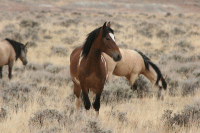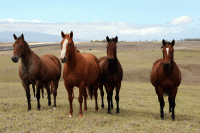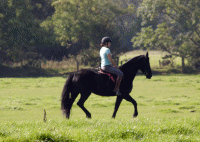Horse Breeds from Around the World Quiz



One of the fascinating things about travel is meeting the wide variety of horse breeds all around the world. Many of these wonderful breeds can be found here at home in the USA. Take this quiz to see how much you know about the wonderful world of horse breeds.
by Raina Paucar
1. Which wild or feral pony breed lives on Assateague Island?
A. Dales
B. Chincoteague
C. Shetland
D. Connemara
E. Exmoor
2. Which draft horse derived its name from a county in the central Lowlands of Scotland?
A. Percheron
B. Schleswiger
C. Clydesdale
D. Belgium
E. Shire
3. What breed of horses did the Nez Perce Indian tribe help to preserve?
A. Thoroughbreds
B. Kiso
C. Marwari
D. Appaloosa
E. Quarter horse
4. What is the name of the wild horses in Central Asia, also believed to be one of the world's oldest breeds?
A. Arabians
B. Przewalski
C. Brumby
D. Mustang
E. Sanhe
5. What is name of Australia's feral horses?
A. Trakehner
B. Appaloosa
C. Quarter Horse
D. Brumby
E. Thoroughbred
6. America’s feral horses are called...
A. Andalusians
B. Quarter horses
C. Mustangs
D. Lipizzaner
7. What horse breed was developed in Mexico?
A. Bashkir
B. Azteca
C. Cheju
D. Campolina
E. Dongola
8. From which of the below countries does the Criollo originate?
A. Peru
B. Chile
C. Mexico
D. Uruguay
E. Africa
9. Which breed is recognized by registries as a horse, but appears to be pony-sized?
A. Haflinger
B. Belgium
C. Icelandic
D. Morgan
E. Holsteiner
10. Which is a rare horse found in the deserts of Africa?
A. Zebra
B. Arabian
C. Namib
D. Caspian
E. Hequ
Check out the answers to see how you did and learn more fun facts about horse breeds:
1.) The Chincoteague, also know as wild ponies, have inhabited Assateague Island for hundreds of years. It is believed they descendanted from horses that survived a Spanish galleon shipwreck. The northern part of the Island belongs to Maryland, while the southern part Virginia. Every year spectators gather to watch the herd swim from Assateague Island to Chincoteague Island.
2.) The Clydesdale originates from Scotland. The breed was first noted around 1826. The horse is named after the Scottish county of Lanarkshire, through which runs the River Clyde, a major Scottish river. These horses were originally bred for agriculture work and heavy hauling. The use of the Clydesdale has changed over the course of many years. You can learn more about their uses here.
3.) The Appaloosa was ridden and bred by Nez Perce Indian tribe. Historians believe they were the first tribe to breed the Appaloosa for selected traits. During the Nez Perce war, the tribe fled over 1300 miles on the backs of their Appaloosa horses. After the Nez Perce were defeated in Montana, Appaloosas were in decline. In 1938, the Appaloosa Horse Club was founded to help continue to preserve the breed.
4.) The Przewalski (Sheh-VAL-ski) is named after explorer and naturalist, Colonel Nikolai Przhevalsky. He first described these horses in 1881. It was at one time extinct in the wild. It now lives in Mongolia’s national parks, where they are preserving the breed. They are the only true wild horses in the world.
5.) The Brumby is the feral horse of Australia. The largest concentration of the breed are found in Northern Austrailia. Brumbies originated from escaped and abandoned horses that were once pets. There are approximately 400,000 Brumbies in Australia and there is much controversy surrounding how to manage population.
6.) The Mustang is America’s feral horse. They are descents of the Iberian horse, which are several breeds from Spain, Portugal and Andorra. Some of these horses escaped and were captured by Native Americans. Mustangs were also saddle broke by cowboys and used for herding. Mustangs are protected by the Wild Free-Roaming Horses and Burros Act.
7.) The Azteca is a Mexican horse breed created in 1972. This horse’s boodlines are a combination of three breeds; Mexican Criollo, Andalusian and American Quarter Horse. They are very athletic and versatile enough to be used in many riding disciplines.
8.) The Criollo originates from Uruguay and is the preferred mount of the Gaucho, South American cowboys. They are descendants from well bred Spanish stock. This horse is known for its stout conformation and endurance. They don’t require much grazing and are resistant to many diseases.
9.) The Icelandic Horse is often pony-sized. They are sturdy and well bred, with few known diseases, because they are kept isolated in the island nation of Iceland. These horses are gaited and known for their unique ability to tölt and pace. Icelandic horses are still widely used in Iceland to reach areas that vehicles can’t. The Icelandic people have strict laws regarding importing and exporting the Icelandic horse. Watch Equitrekking host Darley Newman as she talks about the Icelandics' special gaits.
10.) The Namib Desert Horse is considered to be the only feral horse in Africa. There are roughly 150 living in the Namib desert. They also hold the distinction of being the second-lowest genetic variation in the entire horse population. There is much speculation about where they originated, since horses are not native to Africa. The first horses were brought to the Cape of Good Hope by the Dutch.
Learn more about horse breeds by watching special videos on horse breeds around the world on Equitrekking.com.
About the Author: Raina Paucar is an adventure loving equestrian and female jockey. She likes to ride fast horses, explore new places, read great books, gadget hoard, play games, take pictures and write. She currently exercises racehorses and works with her own off the track Thoroughbred (OTTB). Her career in media focuses on equestrian lifestyle.




